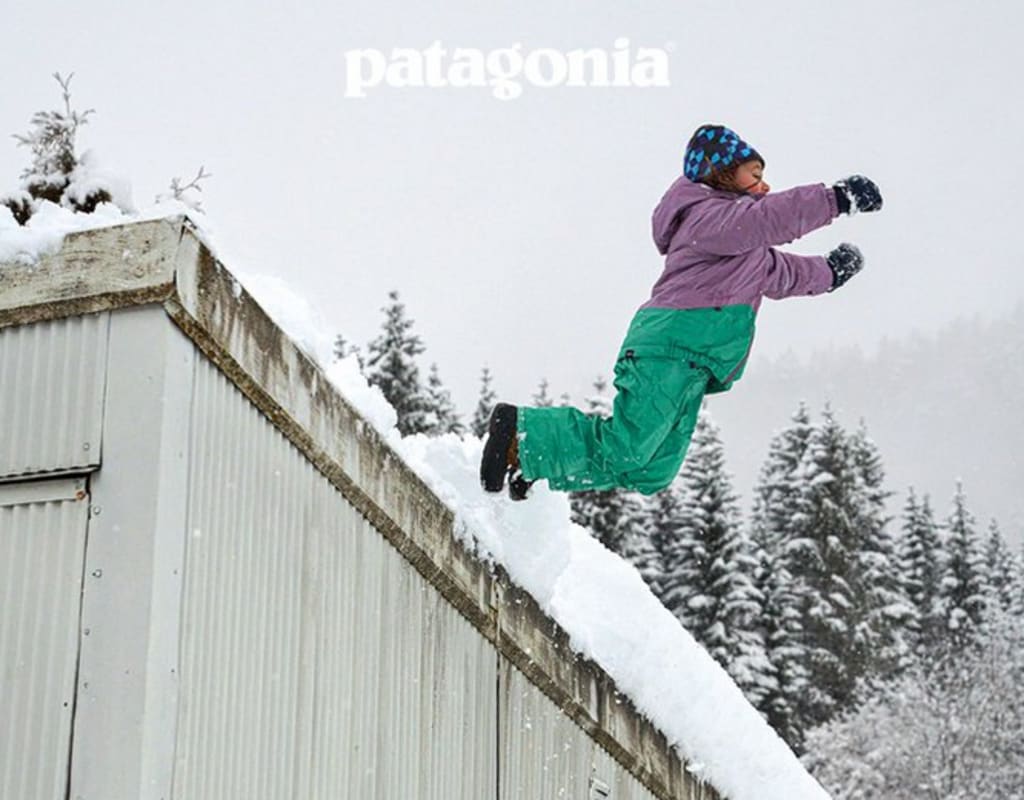Patagonia’s Big Advertising Fail in the Snow
The well-regarded retailer recently issued an ad depicting a young child jumping off a roof into the snow (a big no-no for winter safety). How can a master marketer make such a big advertising mistake and how can you avoid doing so - in whatever you manage - in the future?

Overview
If you are at all involved in marketing anything, then you’ve been there. Whether you are marketing a product, a service, a hospital, a political candidate, or a university, you’ve been there. We’ve all been in a conference room with a group of people with a task of, well, creating something. Whether that be a branding message, a new packaging, a new logo, or an advertisement for any media, we’ve all been in “the room where it happens.” Sometimes, the ideas flow. Creative people are “on their game,” and the results can simply be magic. The “right” mix of creative talent assembled for such a purpose can create a successful marketing vehicle that can, in many cases, not just help the company for a month or for a season, but in the case of branding and logos, pay dividends for decades! The “best” advertisements - for the Web, for print, for audio, for TV, etc. - come from just such creative processes. Those ads do not just become memorable in the ad business and win industry awards. More importantly, they drive sales and help build a company’s brand image, recognition, and trust in the minds of consumers.
Every once in a while though, you see an ad and simply have to ask a simple question: “What were they thinking?” Or in even blunter terms, you could rightly phrase it as: “What the ‘F’ were they thinking?” As a strategic management consultant and professor, one can point to ads that have become memorable for all the wrong reasons…
And what is amazing about the “marketing fails” that have occurred over the years is that companies that are highly regarded for their savvy marketing and advertising - the Coca-Cola’s, the Pepsi’s, the Ford’s, the McDonald’s and more - are quite often the ones that not just produce ads that stumble and cause negative publicity. What is remarkable is just how badly they can do so at times. While no one “bats a thousand” at anything - especially when it comes to advertising, when a prominent consumer-facing company has a “marketing misstep,” in today’s world, social media can greatly amplify the firm’s marketing mistake and make an ad a sensation. And while the age-old adage is that “there’s no such thing as bad publicity,” no company wants to be trending on Twitter for the wrong reasons.
Today, that is the situation facing Patagonia. The clothing and outdoor retailer is widely regarded as one of the best marketers and most socially responsible companies in America, routinely making seemingly almost every “best of” list today. Yet presently, Patagonia has been the subject of much discussion on social media for an ad that seems, to most of the “ad experts” out there, to be not just edgy, but depicting an unsafe activity. And even worse, the ad features a young girl promoting their outdoor winter wear, magnifying the problem because it seemingly shows a child engaging in a highly unsafe, risky behavior.
And so how did a room full - or in 2021 - likely, a hybrid mix of in-person and Zoom-joining very talented individuals, not just come up with an idea for an ad that depicts a child literally jumping off a roof while wearing your gear, but execute it and launch into the marketplace - with the results one might expect in today’s world of social media? We explore that in this article, as Patagonia’s rare marketing stumble has an important lesson for anyone involved in marketing anything - and really, for anyone managing people - today!

The Patagonia “Jump Off the Roof” Ad
So what is all the controversy about? Well, take a look at “Exhibit A” for yourself. Patagonia promoted its winter “snow gear” for kids with the following tweet:
Their tweet was an advertisement, which when you clicked on the link embedded in the line, “Made for Generations of Warmth,” you would be taken to Patagonia’s website to view their Kids' & Baby Snow Collection:

Source: Patagonia, November 2021
This is the kind of ad that companies routinely run many, many thousands of times everyday across social media platforms! But, if it struck you as odd that the ad depicts a young girl actually jumping off a roof into the snow, well, you’re not alone! Now as one who is based just outside of New Orleans (where “snow” [usually just freezing “mush” that doesn’t even stick to the ground] is rare and typically only happens every few years), I did not realize just how problematic the photo used by Patagonia in its ad was beyond just having a child apparently jumping off the roof of their family home. Now, a rule of thumb for any advertising is that you generally do not want to show kids engaging in any risky behaviors when trying to sell your clothing line - and jumping off any roof at any time has a high likelihood of ending in a trip to the emergency room. However, those who live in colder climates know very well that jumping into snow can be especially risky. This is because snow quite often completely masks what lies beneath the surface. As such, anyone - of any age - who jumps into snow from any height - especially from any roof - risks not just injury from the fall, but injury from any sharp, rusty, or otherwise dangerous object - including the hard, frozen ground below - that is hidden by the snowfall!
Like almost anything posted on social media today, Patagonia’s ad drew funny comments (or attempts at being funny) of course…
… But the ad also drew sharp and pointed criticism on social media, specifically for its depiction of a child engaging in what looks to be - almost inarguably - in an especially risky behavior by just jumping off the roof of a house...
… With some Twitter users specifically calling out the company for the fact that the child was not just jumping off her roof, but into the snow below:
Now some Twitter users went beyond, using the Twitter ad as a chance to poke fun at the company’s well-established advocacy against climate change…
Of course as happens with everything today on social media, some Twitter users took the “pro” kids jumping off of roofs argument, arguing that they had done so as kids and survived!
And then there was the Twitter expert who analyzed the physics involved in the ad and deemed it “safe:”
Analysis
So, what are we to make of Patagonia’s surprising marketing stumble? From my analyst’s perspective, I have to agree with this one Twitter commenter:
Exactly how did this happen though? One Twitter user suggested that the ad could have been created using AI (artificial intelligence), which is indeed becoming far more commonplace today in the advertising field:
More likely however, this ad was the result of a human creative process, with an aim of showing their product in a good light…
... with an ad that was ultimately approved by a manager:
And so the “lesson” to be learned from Patagonia’s obvious marketing fail is one that has been learned by other consumer products companies over and over and over again. The problem is a very human one - one that happens all too often in group decision making of all kinds. People tend to latch onto an idea that they think is a good one, and if the group all sees the situation in basically the same way and agree on an idea, that becomes a very powerful force - namely groupthink. Groupthink can be defined in the following manner:
"Groupthink is a phenomenon that occurs when a group of individuals reaches a consensus without critical reasoning or evaluation of the consequences or alternatives. Groupthink is based on a common desire not to upset the balance of a group of people….The Challenger shuttle disaster, the Bay of Pigs, Watergate, and the escalation of the Vietnam War are all considered possible consequences of groupthink."
And so one can easily imagine the creative team at Patagonia and their advertising agency working through their seasonal ad campaigns and having this picture of the child model dressed in Patagonia snow gear and just said, “Let’s go with it!” Those involved almost assuredly had absolutely no ill-intent about the ad. Those involved also had no idea how poorly it would be received.
What was needed to avoid the groupthink that launched this ill-advised ad? It’s simple. And yes, it’s an important lesson for us all. If you are in charge of any group - an advertising team or any other group of people charged with making decisions, you need to encourage truly open dialogue within the group. This is vitally important, so as to prevent the kind of groupthink that can lead to truly poor outcomes - and sometimes disastrous one! Another time-proven management technique is to - formally or informally - have someone in the group purposely act as a “Devil’s Advocate.” No, we’re not talking about the scary/cheesy 1997 Dustin Hoffman/Keanu Reeves movie of that name:
No, we’re not talking about being a Devil’s Advocate, at least in the way that the Urban Dictionary defined it:
“Someone who chooses to say the opposite of what another person thinks or says, simply to be an asshole.”
Rather, we’re talking about using a Devil’s Advocate in the classical way, which can be defined as:
“Someone who pretends, in an argument or discussion, to be against an idea or plan that a lot of people support, in order to make people discuss and consider it in more detail.”
If someone at Patagonia had been assigned the Devil’s Advocate role in this instance, perhaps he or she could have brought the issues with the picture for the ad the the fore. Even if he or she might not have seen a serious issue in using the picture of the youngster jumping off the roof into the snow, it is very likely that through more intense scrutiny of the picture and the situation being depicted, someone would have taken note and perhaps saved Patagonia some significant embarrassment over this particular advertisement.
And so if you are in charge of any decision-making group or process, you should take note of the Patagonia experience and see just how important it is to set-up a situation where there is the necessary thinking, the vital discussion, the due diligence that can help you avoid a potentially damaging course of action. By employing a “Devil’s Advocate,” you can substantially lessen the chance that the group or team you lead - and even yourself - might fall into the groupthink trap. Taking this simple and time-proven step might just save you a great deal of embarrassment and negative consequences - and maybe even your career!
++++++++++++++++++++++++++++++++++++++++++++++++++++
About David Wyld
David Wyld is a Professor of Strategic Management at Southeastern Louisiana University in Hammond, Louisiana. He is a management consultant, researcher/writer, publisher, executive educator, and experienced expert witness. You can view all of his work at https://authory.com/DavidWyld.
Social Media Links to David Wyld:
About the Creator
David Wyld
Professor, Consultant, Doer. Founder/Publisher of The IDEA Publishing (http://www.theideapublishing.com/) & Modern Business Press (http://www.modernbusinesspress.com)






Comments
There are no comments for this story
Be the first to respond and start the conversation.